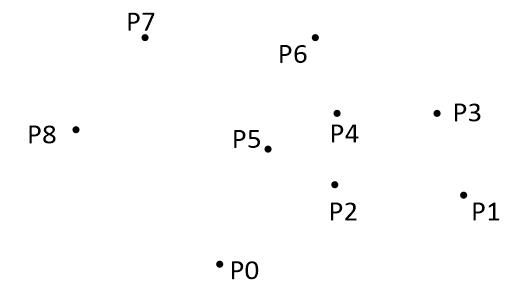最小凸包算法
Posted Thomas会写字
tags:
篇首语:本文由小常识网(cha138.com)小编为大家整理,主要介绍了最小凸包算法相关的知识,希望对你有一定的参考价值。
使用Graham扫描法进新解决最小凸包问题
先找到最左下端点
然后根据极角来进行逆时针排序
在根据相对极角增减来去除不需要的点

C++代码
#include<iostream>
#include<cstdio>
#include<cstring>
#include<algorithm>
#include<cmath>
#define PI 3.1415926535
using namespace std;
struct node
{
int x,y;
};
node vex[1000];//存入的所有的点
node stackk[1000];//凸包中所有的点
int xx,yy;
bool cmp1(node a,node b)//排序找第一个点
{
if(a.y==b.y)
return a.x<b.x;
else
return a.y<b.y;
}
int cross(node a,node b,node c)//计算叉积
{
return (b.x-a.x)*(c.y-a.y)-(c.x-a.x)*(b.y-a.y);
}
double dis(node a,node b)//计算距离
{
return sqrt((a.x-b.x)*(a.x-b.x)*1.0+(a.y-b.y)*(a.y-b.y));
}
bool cmp2(node a,node b)//极角排序另一种方法,速度快
{
if(atan2(a.y-yy,a.x-xx)!=atan2(b.y-yy,b.x-xx))
return (atan2(a.y-yy,a.x-xx))<(atan2(b.y-yy,b.x-xx));
return a.x<b.x;
}
bool cmp(node a,node b)//极角排序
{
int m=cross(vex[0],a,b);
if(m>0)
return 1;
else if(m==0&&dis(vex[0],a)-dis(vex[0],b)<=0)
return 1;
else return 0;
/*if(m==0)
return dis(vex[0],a)-dis(vex[0],b)<=0?true:false;
else
return m>0?true:false;*/
}
int main()
{
// t是点的个数 L没用到 vex是输入点集
int t,L;
while(~scanf("%d",&t),t)
{
int i;
for(i=0; i<t; i++)
{
scanf("%d%d",&vex[i].x,&vex[i].y);
}
if(t==1)
printf("%.2f\\n",0.00);
else if(t==2)
printf("%.2f\\n",dis(vex[0],vex[1]));
else
{
memset(stackk,0,sizeof(stackk));
sort(vex,vex+t,cmp1);
stackk[0]=vex[0];
xx=stackk[0].x;
yy=stackk[0].y;
sort(vex+1,vex+t,cmp2);//cmp2是更快的,cmp更容易理解
stackk[1]=vex[1];//将凸包中的第两个点存入凸包的结构体中
int top=1;//最后凸包中拥有点的个数
for(i=2; i<t; i++)
{
while(i>=1&&cross(stackk[top-1],stackk[top],vex[i])<0) //对使用极角排序的i>=1有时可以不用,但加上总是好的
top--;
stackk[++top]=vex[i]; //控制<0或<=0可以控制重点,共线的,具体视题目而定。
}
double s=0;
//for(i=1; i<=top; i++)//输出凸包上的点
//cout<<stackk[i].x<<" "<<stackk[i].y<<endl;
for(i=1; i<=top; i++) //计算凸包的周长
s+=dis(stackk[i-1],stackk[i]);
s+=dis(stackk[top],vex[0]);//最后一个点和第一个点之间的距离
/*s+=2*PI*L;
int ans=s+0.5;//四舍五入
printf("%d\\n",ans);*/
printf("%.2lf\\n",s);
}
}
}MATLAB代码
%% 本函数作用就是使用Graham扫描法进新解决最小凸包问题
function Stack = GrahamNew(Spots)
%% 任意画出坐标点
clc
clear all
close all
img=ones(256,256);
imshow(img);
[x,y]=ginput();
x=round(x);
y=round(y);
n=length(x);
p=[];
for i=1:n
img(y(i)-1:y(i)+1,x(i)-1:x(i)+1)=0;
p=[p;x(i) y(i)]; %待判断凸包的点集
end
imshow(img);
Spots = p;
N = size(Spots,1);
if N<3 % 点太少不符合要求
exit();
end
%% 此函数的作用是给随机坐标点进行逆时针排序
% 找到最左下端点
Temp = [Spots(:,2) Spots(:,1)];
Temp = sortrows(Temp);
X = Temp(1,2);
Y = Temp(1,1);
Angle = [];
for k = 1:N
dy = Spots(k,2) - Y;
dx = Spots(k,1) - X;
Angle = [Angle;mod(atan2(dy,dx), 2*pi)];
end
NewSpots = [Angle,Spots];
NewSpots = sortrows(NewSpots);% 完美解决了极角相同的点
NewSpots = NewSpots(:,2:3);
%% 使用栈进栈出原理将不符合要求的点去除
Stack = [];
Stack = [Stack;NewSpots(1:3,:)];% 压入前3个点
k = 4;
while(k<=N)
top = size(Stack,1);% 模拟栈顶指针
dy = Stack(top,2) - Stack(top-1,2);
dx = Stack(top,1) - Stack(top-1,1);
% 已存入最后线段的极角
theta1 = mod(atan2(dy,dx), 2*pi);
dy = NewSpots(k,2) - Stack(top,2);
dx = NewSpots(k,1) - Stack(top,1);
% 准备存入线段的角度
theta2 = mod(atan2(dy,dx), 2*pi);
if (theta1-theta2)<=0
Stack(top+1,:) = NewSpots(k,:);% 入栈
k = k+1;
else
Stack(top,:) = [];% 弹出栈
end
end
%% 画图测试
Spots = [Spots;Spots(1,:)];
NewSpots = [NewSpots; NewSpots(1,:)];
Stack = [Stack;Stack(1,:)];
figure(1)% 原乱序点的图形
plot(Spots(:,1),Spots(:,2));
axis([0,256,0,256]);
figure(2)% 排序点的图形
plot(NewSpots(:,1),NewSpots(:,2));
axis([0,256,0,256]);
figure(3)% 优化后的凸形
plot(Stack(:,1),Stack(:,2));
axis([0,256,0,256]);
end以上是关于最小凸包算法的主要内容,如果未能解决你的问题,请参考以下文章